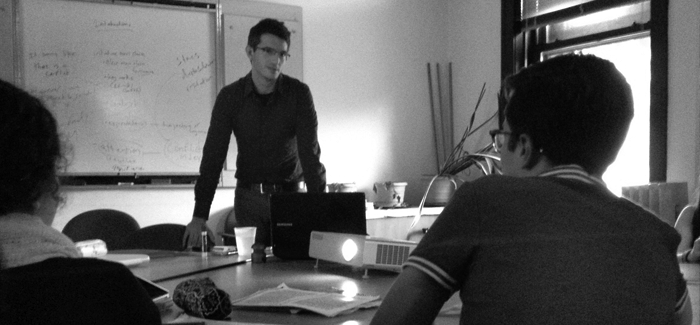
(Photography by Derek Tsang, ’15)
A proper introduction
Peeking into one of UChicago’s many summer programs for high schoolers.
I can’t help but feel nostalgic when I sit down with the 12 teenagers in Collegiate Writing: Art and Meaning, part of the UChicago’s Insight summer program for high schoolers. The small polygon of a classroom filled with precociously big ideas evokes my own experience in the Core, taking Readings in World Literature as a first-year, and even my dalliance with a similar program before my senior year of high school. The class’s format is adapted from the Core too: afternoons are devoted to discussions of art, and the students have weekly writing seminars. Instructor Michael Subialka, AM’09, PhD’12, buffs the focus on writing, though, with morning sessions akin to the College’s Little Red Schoolhouse course on academic writing.
After starting with a quick review on the overall structure of a paper, Subialka drills the students on the purpose of introductions and their proper arrangement. He is a professor at Bilikent University in Turkey, where he delves into the intersections between art, philosophy, and literature, and, despite his youth, he’s an experienced teacher. This is his fourth time teaching summers here, and Subialka put in time as a writing intern, then as a full-fledged teacher, for the Core’s Reading Cultures.
Subialka returns again and again to the importance of clarity and nuance. “You’re not dealing with a reader who’s going to close read,” he reminds the class. “So your reader should be able to see clearly, immediately, manifestly, right in front of her eyes.” His use of the female pronoun for the reader is a convention in analytic philosophy, he says, which he studied as an undergraduate at Notre Dame.
The strongest introductions construct a sense of problem through “stasis, destabilization, resolution,” he argues, explaining that it should create or point at a “popular assumption,” introduce a complication, and then resolve it through the paper’s main claim. In an example from Freud, the stasis is the “stuffy Victorian morality,” says Subialka, destabilized by his assertion that man is an animal and resolved (arguably) through his theory of the id, ego, and superego.
The students dissect introductions Subialka shows from past iterations of the class then craft introductions for their papers—due that night at seven—and share them with partners.
After they finish up, they break for a two-hour lunch, half of which Subialka spends holding office hours. This is, after all, a summer camp; the students stay in dorms and have the weekends free of classes and assignments. The students—rising sophomores, juniors, and seniors—come from as far as Belgium, Turkey, Puerto Rico, and Japan. To get them acquainted with the city, the program provides planned trips to local restaurants, Hyde Park’s farmers’ market, Seven Ten Lanes, and a variety of other happenings in the city.
[[{"type":"media","view_mode":"media_original","fid":"857","attributes":{"alt":"","class":"media-image","height":"216","typeof":"foaf:Image","width":"460"}}]]
The morning was Subialka’s time to shine—spontaneous smile, clarion voice, professor-corny jokes and all—and now, in the afternoon, the focus is on the students. Each is responsible for one 15-minute presentation, staggered throughout the course’s three weeks. We hear first from Marcelo, who shows us an excerpt from Kenneth Anger’s controversial Fireworks. It’s “a film obsessed with the technical and metaphorical nature of light,” he argues, highlighting the “pyrotechnic orgasms” and high contrast lighting in the segment he plays.
Next up is Michael, discussing the relationship between Picasso’s art and the wars that plagued Europe during his lifetime. His PowerPoint is stuffed with melodramatic humor, pierced by some surprising insights. “When Picasso read about the atrocities in Guernica,” he explains, “for the first time, he decided to do something about it. I call it cubism with a conscience.”
Having looked at art in practice, the class now turns to it in theory, busting out their copies of Andre Breton’s Surrealist Manifesto to continue an ongoing discussion of art as revolution. Subialka scans the class for overall impressions, which range from enjoyment and amusement to downright antagonism. “I don’t like it,” says Cody, perched on the table’s far side. “It’s like they’re trying to be radical. It’s artificial.”
The class then dives into passages that demonstrate and explain exactly what surrealism is, starting from Breton’s proposed example of randomized “newspaper headlines” and eventually reaching a consensus that the text itself—lyrical and incomprehensible by turns—practices the surrealism that it preaches.
Breton and the surrealists pioneered automatic, or “free,” writing—writing by association, supposedly too fast for the conscious mind to catch up and censor—and the class zeroes in on this as indicative of the surrealist ideal, that the subconscious can produce beauty and meaning otherwise inaccessible.
The Manifesto says “that life is so interesting, but we miss it so often,” according to one student. With surrealism’s curious form of beauty and “with the Renaissance idea of beauty, it’s really the mind where we find beauty.”
Echoing that thought, Subialka gives the class a quick summary of the psychoanalysts’ similar ideas about the mind, before asking them what Breton means by praising the “wonderful,” not the beautiful, and the class is voluble, but stumped. As they’re running out of time, they hit on Breton’s assertion that in writing his manifesto, he wrote “the serpentine, distracting lines of this preface” as a potential answer to Subialka’s riddle.
The students—many of whom took the class seeking a balance to their math- and science-centric high schools—depart to write their papers, on T. S. Eliot’s Four Quartets and that eternal subject: the meaning of art. Maybe they’ll be the ones to figure it out.
